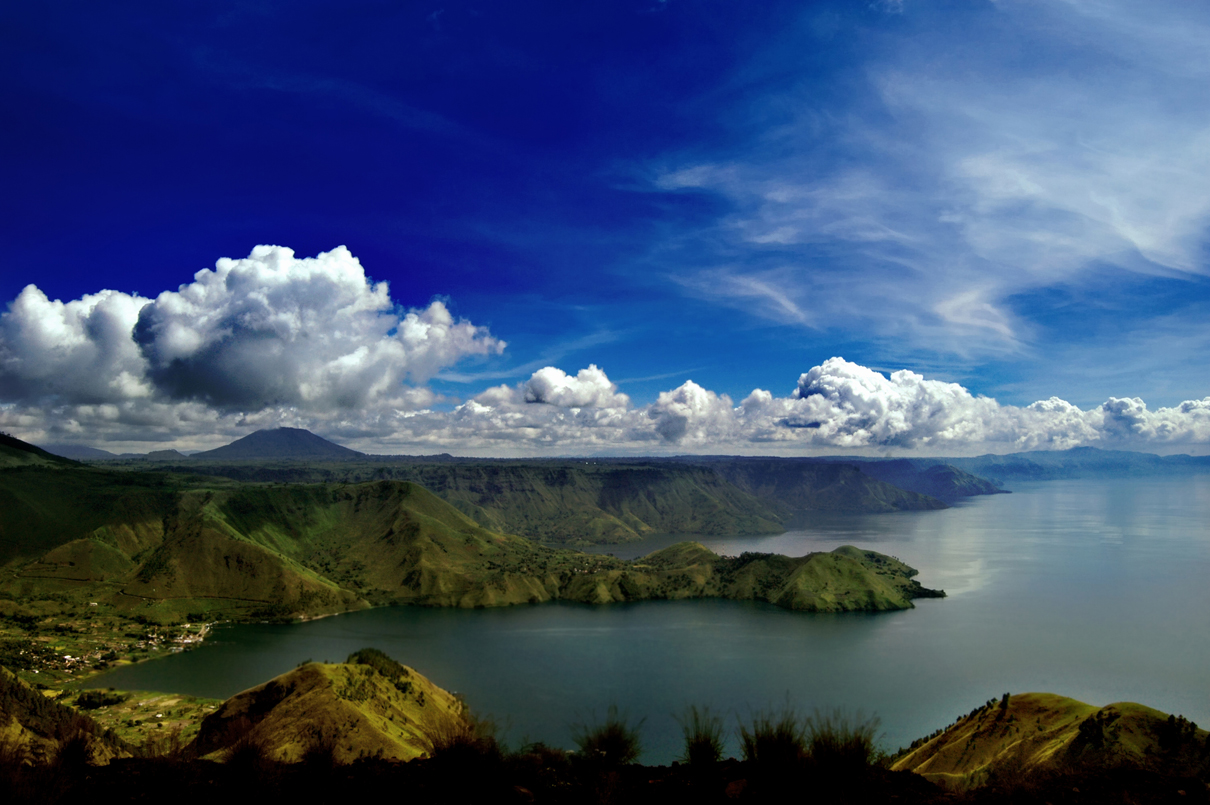The unique philosophy and culture of the Bataks places great importance on customs and culture inherited from ancestors. A lot of culture stemming from primitive times continues to live on, somewhat modified to suit modern times.
The gorga, is an ancient Batak art, sculptures featuring three specific natural colours. Gorga are often seen on the walls of traditional houses. Previously, gorga were only made for the houses of important members of society. This is due to the belief that the gorga wasn't just decorative, but mirrored the Batak way of life. A shaman or datu would give the instructions for making the sculpture. Datu were seen as respected members of society due to their role in helping others. Datu were always involved in rituals and art, including in the process of making gorga. The different Batak cultural arts are all connected.
Once upon a time, there was a respected and well-known datu. His name was Gambut Nabolon. He had a wife called Siboru Jongjong Anian Siboru Tibal Tudoson (Don't be surprised by the length of the name; Batak names contain important meanings and imply status). They were happy enough, and they were full of hope that their child would be as skilled as its father. Until one day, they were blessed with a child. Surprisingly, Siboru Jongjong Anian Siboru Tibal Tudoson gave birth to three children at once. The father called them Pustaha Anggir, Lada, and Napuran. They were hoped to become shaman with a knowledge of craftsmanship when they reached adulthood.
Time passed. The mother gave birth a second time. This time she gave birth to twins. The twins were named Sirat and Uhir. They too were hoped to have skills of craftsmanship, in making thread, weaving and making traditional Batak cloths (ulos). Soon after, the mother gave birth again, this time one boy and one girl. They were named Si Aji Donda Hatahutan and Siboru Sopak Nauasan or Siboru Sopak Panaluan. The datu was very happy, because he loved having a large family.
An old Batak saying is anak do hamoraon, meaning “lots of children, lots of luck”.
There is a Batak idiom which shows the importance of big families in Batak culture:
Laklak ni sikkoru, nagantung di tiang pintu,
Maranak sampulu tolu, marboru sampulu pitu.
The meaning is something like, "Sikkoru wood over the door, 13 girls, 17 boys".
To keep the story short, the datu's children soon grew up. The datu realised that it wasn't easy teaching his children to become as he had wished for. The oldest son, Aji Donda Hatahutan was the one who was most able to understand the art of shamanism and craftsmanship. His youngest daughter became an expert in making ulos. Only after the youngest had become an great craftswoman, the others followed.
The children always lived full of ambition to create. One day, when Siboru Sopak Nauasan was busy embroidering, the three threads fell to the floor in disarray. Aji Donda Hatahutan was hypnotised by the sight. Suddenly he took a sharp knife and begun engraving the doors and walls of the house. The parents and siblings were shocked, believing that Aji Donda Hatahutan was possessed by a spirit. They decided to prepare a mat made from pandan leaves, a jug filled with drinking water with tamarind, incense and coal in order to exorcise the spirit. Aji Donda Hatahutan was made to sit on the mat. The father prayed to Debata Mulajadi Nabolon (the Batak name for God).
They became even more confused because at that point Aji Donda Hatahutan became truly possessed. The spirit in his body told the father to collect wood for building a traditional Batak house or Ruma Bolon. Then Aji Donda Hatahutan, still possessed by the spirit, began to engrave the entire house. The engravings, later to be known as gorga, were so beautiful that the house was called Ruma Gorga (gorga house). The family was very proud of his creation. Since that time some Batak youths began to study become craftsmen (pande) who produced unique and new creations. A pande always passes on the skill to his descendants.
There are a number of famous Batak gorgas made by Batak artists such as gorga pea, silunduni pahu, ipon-ipon, hoda-hoda, adop-adop, sitompi, simataniari, desa naualu, bindu natonga, singa-singa, boras pati, jaga dompak, jorngom-jorngom, jenggar, manuk-manuk, patia raja, porhis marodor, ulu paung and simarogung-ogung. Gorga in traditional Batak houses are believed to ward off evil spirits. Each kind of gorga has a special name and meaning. Gorgas are crafted according to the character of the house owner. Gorgas can symbolise bravery, harmony, riches, knowledge, fertility, beauty, respect, equality, and so on.
The beautiful curves of the gorga require patience and care. The gorga craftsmen live a simple life, because their aim in life is art, not riches. Most of the best gorga artists come from Samosir in Lake Toba and North Tapanuli. One friend of mine has even made gorga in Jakarta. In Siborongborong, one can find the Seni Era Baru workshop which belongs to Oppung (Grandfather) Simatupang. Generally, Balige art is more progressive than in other areas of North Sumatera.
The gorga have indeed involved. Previously, they were always engraved in a specific kind of wood, but now the craftsmen are known to engrave cement or stone. Some artists just paint the motive without engraving it first. This type is known as gorga dais. Nowadays, gorga are used extensively as decoration in government buildings, graves, hotels, modern houses, restaurants and are sold as souvenirs.
"Even though artists have modernised the gorga, the cultural and spiritual meaning of the gorga is still valid," comments a gorga artist acquaintance. Now... would you like to know more about gorga or purchase one or even explore the spiritual values behind them? Then you should pay these craftsmen a visit.

























